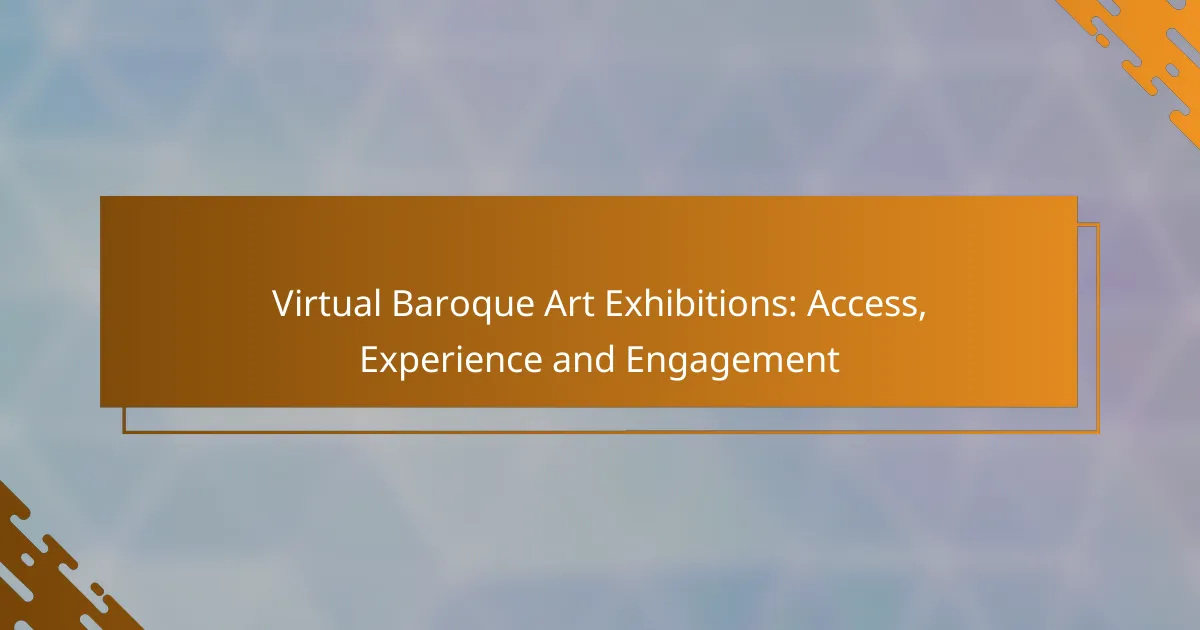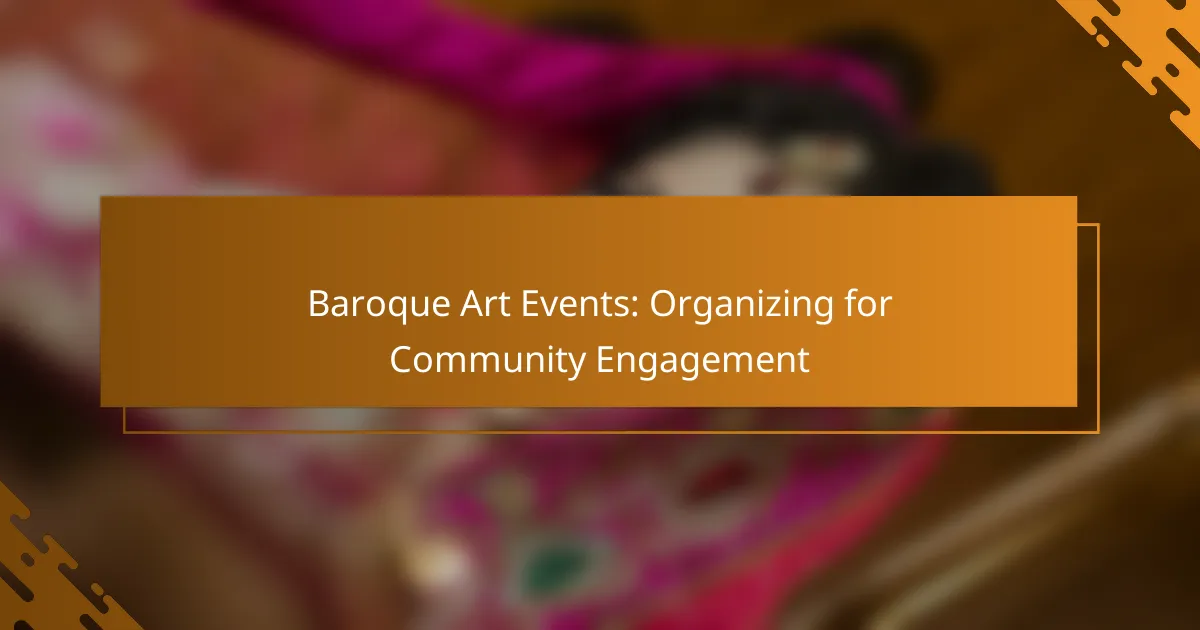Virtual Baroque art exhibitions offer art enthusiasts an accessible way to explore masterpieces from renowned institutions like The National Gallery, Rijksmuseum, and Uffizi Gallery. With various online platforms available, these exhibitions often provide immersive experiences that can be enjoyed from the comfort of home, frequently at little to no cost. Engaging with advanced technology and interactive elements can further enhance the appreciation and enjoyment of these artistic treasures.
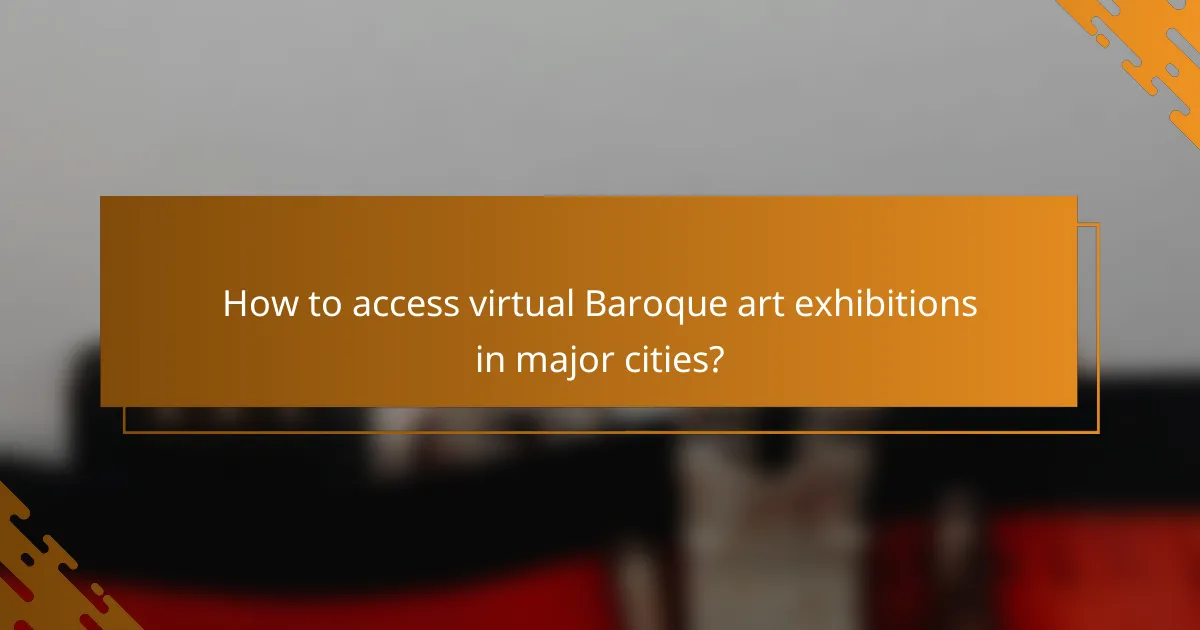
How to access virtual Baroque art exhibitions in major cities?
Accessing virtual Baroque art exhibitions in major cities is straightforward, with various online platforms and museum initiatives available. These resources allow art enthusiasts to explore Baroque masterpieces from the comfort of their homes, often for free or at a low cost.
Online platforms like Google Arts & Culture
Google Arts & Culture offers a vast collection of virtual exhibitions featuring Baroque art from renowned museums worldwide. Users can navigate through high-resolution images and curated content, making it an excellent starting point for anyone interested in this art movement.
To access these exhibitions, simply visit the Google Arts & Culture website or app, search for “Baroque art,” and explore the available collections. This platform is user-friendly and accessible on various devices, including smartphones and tablets.
Virtual tours offered by museums
Many major museums provide virtual tours that allow visitors to experience Baroque art exhibitions as if they were physically present. Institutions like the Louvre in Paris and the Rijksmuseum in Amsterdam have developed immersive online experiences that showcase their Baroque collections.
These virtual tours often include audio guides and detailed descriptions, enhancing the viewer’s understanding of the artworks. Check the websites of specific museums for availability, as some may require registration or have limited access times.
Ticketing options for live-streamed events
Some museums and galleries offer live-streamed events that feature expert talks and guided tours of Baroque exhibitions. These events typically require a ticket purchase, which can range from a nominal fee to more substantial amounts, depending on the institution and the event’s exclusivity.
To participate, visit the museum’s website to find upcoming live-streamed events, review ticket prices, and secure your spot. Be aware that these events may have limited seating, so early registration is advisable to ensure access.
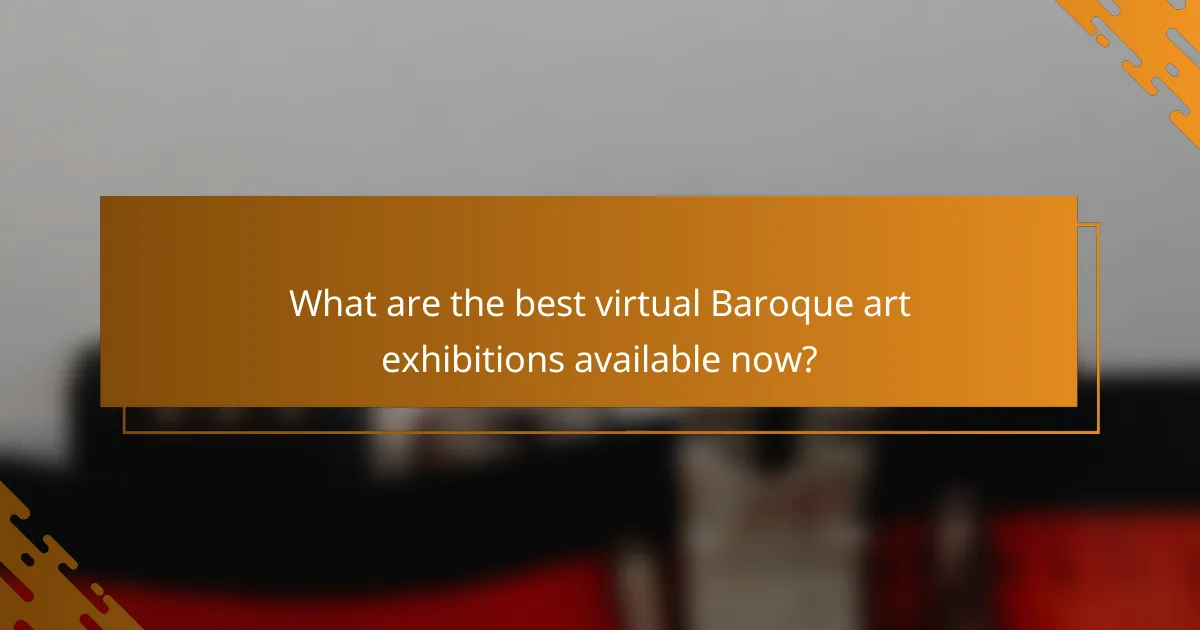
What are the best virtual Baroque art exhibitions available now?
The best virtual Baroque art exhibitions currently available include offerings from renowned institutions like The National Gallery, Rijksmuseum, and Uffizi Gallery. These exhibitions provide immersive experiences that allow art enthusiasts to explore Baroque masterpieces from the comfort of their homes.
The National Gallery’s Baroque Collection
The National Gallery in London features an extensive collection of Baroque art, showcasing works by artists such as Caravaggio and Rembrandt. Their virtual exhibition allows visitors to view high-resolution images of paintings, along with detailed descriptions and historical context.
To navigate the collection, users can filter by artist, period, or theme. This interactive approach enhances the experience, making it easier to appreciate the nuances of Baroque art. Engaging with the gallery’s educational resources can further enrich understanding.
Rijksmuseum’s Virtual Baroque Experience
The Rijksmuseum in Amsterdam offers a captivating virtual experience focused on Baroque art, featuring iconic pieces from Dutch masters like Vermeer and Hals. The online platform includes 360-degree views of artworks and detailed narratives about each piece.
Visitors can take advantage of guided tours that highlight key works and themes within the Baroque period. The museum also provides access to a variety of multimedia content, including videos and interviews with art historians, which can deepen appreciation for the era.
Uffizi Gallery’s Online Exhibitions
The Uffizi Gallery in Florence presents a selection of its Baroque masterpieces through virtual exhibitions. This platform allows art lovers to explore works by Caravaggio and Artemisia Gentileschi, complete with insightful commentary and historical background.
Users can engage with interactive features, such as zooming in on details and comparing different artworks side by side. The Uffizi also offers educational materials that can help viewers understand the significance of Baroque art in the broader context of art history.

How to enhance your experience of virtual Baroque art exhibitions?
To enhance your experience of virtual Baroque art exhibitions, consider using advanced technology and engaging with interactive elements. This approach allows for a deeper appreciation of the art and creates a more immersive experience.
Using VR headsets for immersive viewing
Using VR headsets can significantly elevate your viewing experience of Baroque art exhibitions. These devices provide a three-dimensional perspective, allowing you to explore artworks as if you were physically present in the gallery.
When selecting a VR headset, consider options like the Oculus Quest or HTC Vive, which are popular for their high-quality visuals and user-friendly interfaces. Ensure your internet connection is stable to avoid interruptions during the experience.
Participating in live Q&A sessions
Live Q&A sessions during virtual exhibitions offer a unique opportunity to interact with art historians and curators. Engaging in these discussions can deepen your understanding of the Baroque period and the specific artworks on display.
To maximize this experience, prepare questions in advance and participate actively. Many exhibitions provide a chat feature, so be ready to share your thoughts and ask for clarifications on the art pieces.
Engaging with interactive features
Interactive features in virtual exhibitions, such as clickable artworks and guided tours, enhance your engagement with Baroque art. These tools allow you to learn more about specific pieces and their historical context.
Look for exhibitions that offer multimedia content, such as videos or audio guides, which can provide additional insights. Be cautious of overwhelming yourself with too much information; focus on a few key pieces to fully appreciate their details.
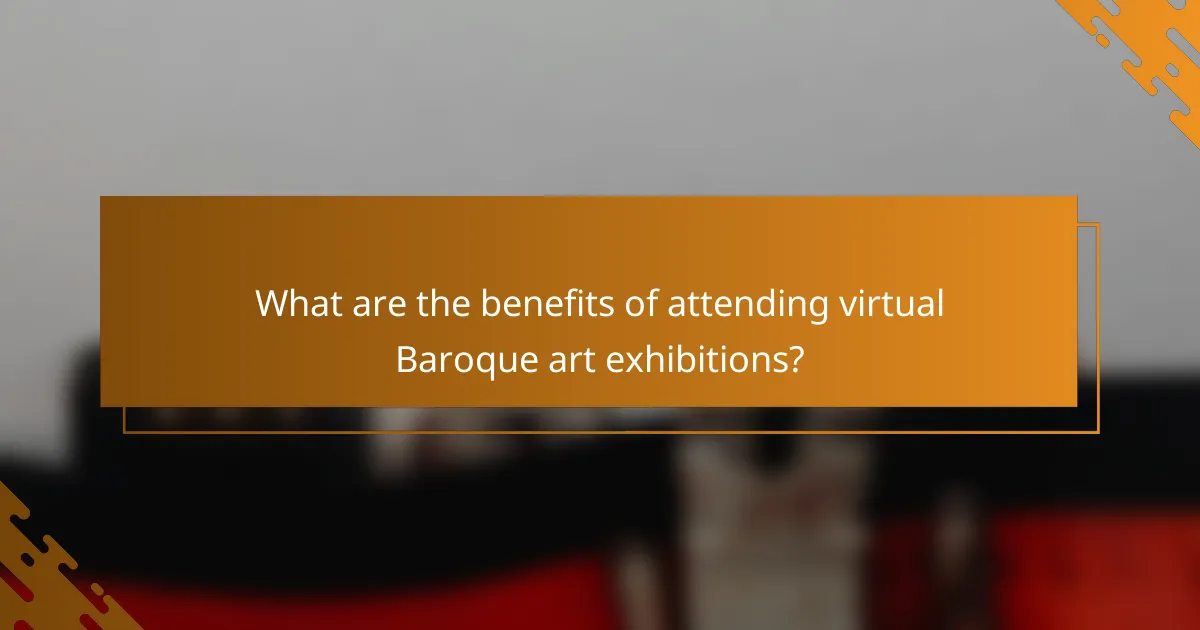
What are the benefits of attending virtual Baroque art exhibitions?
Attending virtual Baroque art exhibitions offers numerous advantages, including greater accessibility, cost savings, and enhanced educational opportunities. These benefits make it easier for art enthusiasts to engage with Baroque masterpieces from the comfort of their homes.
Accessibility from anywhere in the world
Virtual Baroque art exhibitions can be accessed from any location with an internet connection, eliminating geographical barriers. This means that individuals who may not have the means to travel to major art hubs can still experience these cultural treasures.
Many exhibitions are designed to be user-friendly, allowing visitors to navigate through galleries and view artworks at their own pace. This flexibility enhances the overall experience, making it more inclusive for diverse audiences.
Cost-effective alternatives to physical visits
Participating in virtual exhibitions often incurs minimal or no costs compared to traditional visits, which may involve travel expenses, entry fees, and accommodation. Many online exhibitions are free or offer affordable ticket options, making them accessible to a wider audience.
Additionally, virtual events can provide opportunities for interactive experiences, such as live Q&A sessions with curators or artists, which may not be available during in-person visits. This added value can make virtual attendance a more appealing option.
Enhanced educational resources
Virtual Baroque art exhibitions frequently include a wealth of educational materials, such as detailed descriptions, video tours, and expert commentary. These resources deepen the understanding of the artworks and their historical context, enriching the viewer’s experience.
Many platforms also offer supplementary activities, such as workshops or lectures, which can further engage attendees and foster a greater appreciation for Baroque art. This focus on education makes virtual exhibitions a valuable resource for students, educators, and art lovers alike.
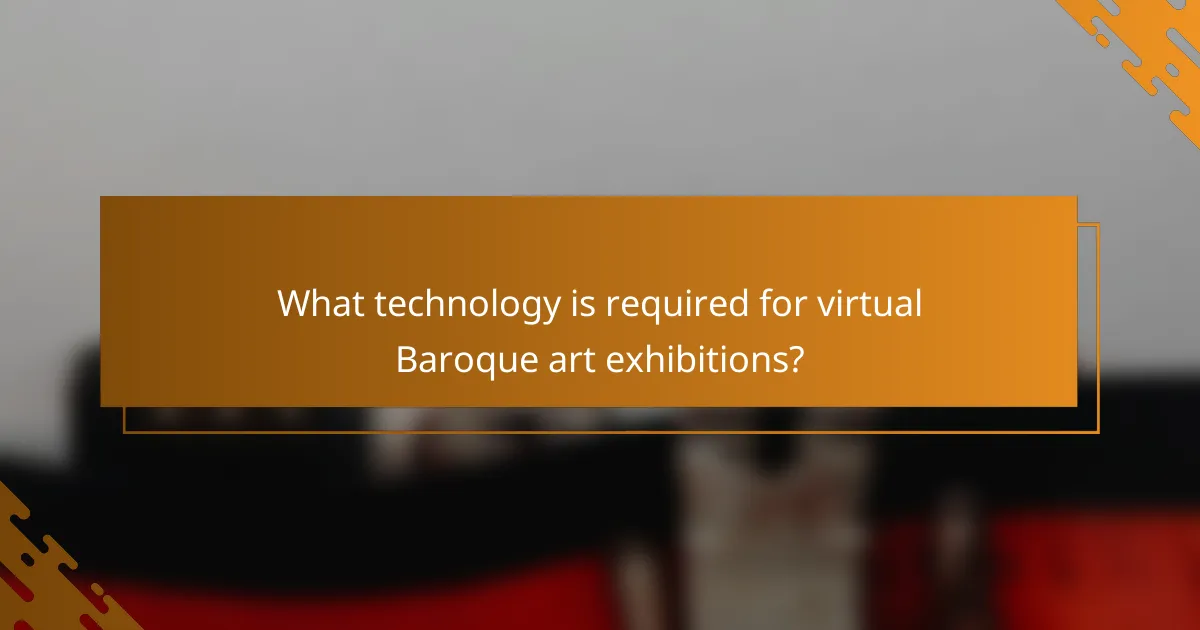
What technology is required for virtual Baroque art exhibitions?
To access virtual Baroque art exhibitions, users need specific technology that includes compatible devices, adequate internet speed, and appropriate software. This ensures a smooth and engaging experience while exploring the intricate details of Baroque art.
Compatible devices for viewing
Virtual Baroque art exhibitions can be accessed on various devices, including desktop computers, laptops, tablets, and smartphones. For the best experience, a device with a larger screen is recommended, as it allows for better visualization of the artwork’s details.
Additionally, virtual reality (VR) headsets can enhance the experience by providing immersive environments. Popular VR headsets like Oculus Quest or HTC Vive are suitable for those looking to engage more deeply with the exhibitions.
Internet speed recommendations
A stable internet connection is crucial for streaming virtual exhibitions without interruptions. A minimum speed of 5 Mbps is generally recommended for standard viewing, while 25 Mbps or higher is ideal for high-definition content.
For interactive features or VR experiences, consider speeds of 50 Mbps or more to ensure smooth performance. Users should also check their connection stability, as fluctuations can disrupt the viewing experience.
Software requirements for interactive features
To fully engage with interactive elements of virtual Baroque art exhibitions, users may need specific software or browser capabilities. Most exhibitions are compatible with modern web browsers like Google Chrome, Firefox, or Safari, which should be updated to the latest versions.
Some exhibitions may require additional plugins or applications, especially for VR experiences. Always check the exhibition’s website for any specific software requirements to ensure a seamless experience.

How do virtual Baroque art exhibitions compare to in-person visits?
Virtual Baroque art exhibitions offer a different experience than in-person visits, primarily in terms of engagement and accessibility. While they provide convenience and wider access, they may lack the immersive quality and emotional impact of physically being in a gallery.
Differences in engagement levels
Engagement levels in virtual exhibitions can vary significantly from in-person experiences. Visitors at physical galleries often feel a deeper connection to the artwork, influenced by the atmosphere and scale of the pieces. In contrast, virtual exhibitions may offer interactive elements, such as 360-degree views or guided tours, but they can still fall short in replicating the emotional resonance of being present with the art.
To enhance engagement in virtual settings, consider participating in live-streamed discussions or interactive Q&A sessions with curators. These opportunities can foster a sense of community and connection that might be missing in a solitary viewing experience.
Accessibility and convenience factors
Virtual Baroque art exhibitions excel in accessibility and convenience, allowing anyone with an internet connection to explore artworks from anywhere in the world. This eliminates barriers such as travel costs and physical limitations, making art more available to diverse audiences.
However, the convenience of virtual exhibitions can come with trade-offs. For instance, while you can view art at your own pace, distractions at home might detract from the experience. To maximize your enjoyment, set aside dedicated time for viewing and minimize interruptions, similar to how you would plan a visit to a physical gallery.
